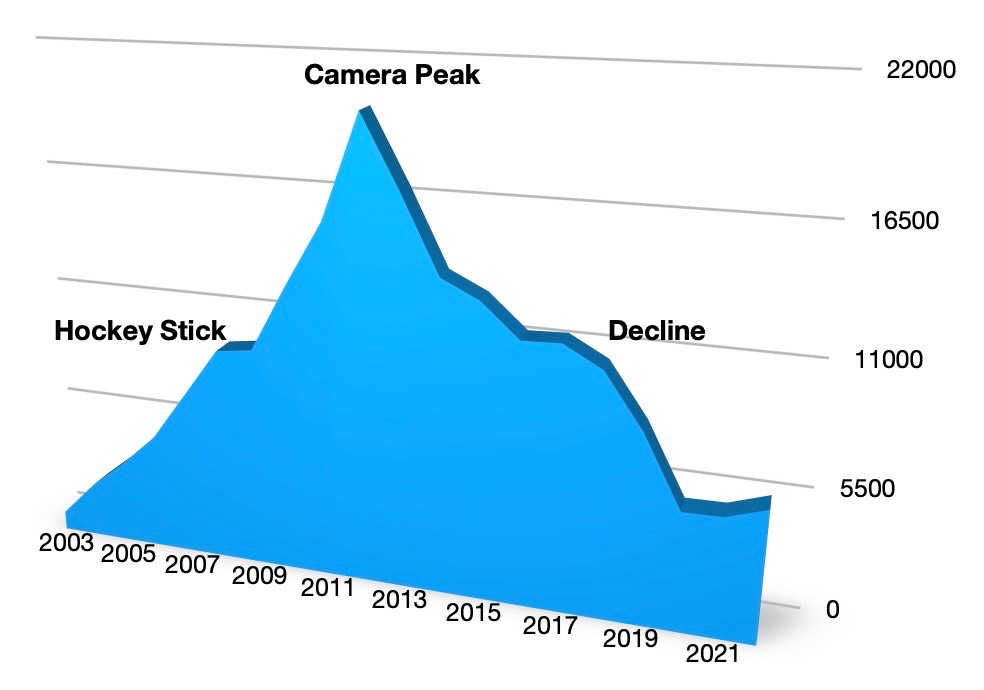I think of digital cameras in terms of sub-eras (Thom's Eras Tour, get your ticket now!).
Up to the turn of the century we had the Experimentation and Testing era for digital. Looking back at 1988 through 1999, there's just an incredible proliferation of, well, very different cameras targeted in very different ways. I remember being shown the original Coolpix 300 prototype in Tokyo and wondering why the heck would I want to low-res draw on my low-res image? Kodak was taking my film SLRs and adding a large brick to them that was tremendously unwieldy to say the least. Some cameras wrote to strange media, too, such as compact discs. No one really understood what might resonate long term with the consumer, so everyone just kept poking around at various ideas of what might.
The D1 in 1999, and especially the D1h and D1x in 2001, triggered the beginning of the Rise of DSLRs era. This was accompanied by the simultaneous Rise of Compacts era in which it seemed that every electronics maker would produce a line, including some you might not expect, such as Hewlett Packard. For a handful of years, the hockey stick of sales turned hugely vertical, and everyone wanted a piece of the fast growing market. Except, perhaps, for Kodak, which thought the margins too slim to push very hard.
Our next era starts in 2007, and it also has two personalities: Establishment of DSLRs and Rise of Smartphones. I got a double dose of "things are about to be different" while climbing Kilimanjaro reading the New York Times and sending images home to loved ones, only to return home and have the Nikon D3 show up on my desk. The iPhone got me thinking a lot about connectivity, while the D3 simply made my imagery suddenly better. The combination of things we had in those two devices led to two simultaneous hockey stick ramp ups. By the time we reach the next era, one hockey stick was done, the other still skyrocketing.
The Decline of DSLRs was inevitable—I correctly predicted the date within six months way back in 2004—and despite attempts to postpone it, the quake, tsunami, and floods of 2011 basically forced the issue. Massive advertising and marketing campaigns tried to keep the trends upward, but Nikon, for instance, found that they couldn't do much in the way of new DSLRs in late 2011—due to one flooded plant and another being rebuilt after the quake—and was mostly stuck selling from remaining inventory along with China-made Nikon 1's instead. Massive supply chain issues hit most of the camera makers, all in different ways, and even if they had wanted to power through Peak Camera Sales, that became difficult, which then turned into impossible.

Parallel to the Decline of DSLRs we had the Slow Rise of Mirrorless. While digital started with experimentation, there was also an inevitable "get rid of mechanical parts and manufacturing alignments" progression that meant mirrorless was always going to take the ILC mantle from DSLRs. Unfortunately, the decline in ILC sales that started in 2012 was one of the things that made mirrorless's rise slow, not rapid. Canon and Nikon, in particular, rushed back to heavy DSLR production as fast as they could after 2011's manufacturing disruptions, and they used the pricing hammer quite often while trying to prop their sales volumes up. Nikon, in particular, got to the point where they left three generations of cameras on sale and had price points pretty much every US$100 for most of their "lineup".
The question everyone had during the teens was "when will the decline end?" The answer wasn't (isn't?) known, because in 2020 the pandemic clearly impacted sales (and in some strange ways we can't assess well). The current prediction and expectation is that 2023 will be another up year from the pandemic bottom.
Which leads me to this: all the Japanese camera companies are predicting a new era: the Rise of Mirrorless. With all the makers now on the same page about what they're making and plenty of pandemic time to settle on strategies for the coming years while finally resolving the second big supply chain problem they've had this century, I've gotten plenty of indications out of Tokyo that 2024 will be an aggressive year for most of the Japanese companies.
Without giving away details, Canon's on course for another four camera year, Fujifilm is on course for at least a three camera year (plus a compact), Nikon will do better than the 2-1-2 of the last three years with at least three new offerings, Panasonic seems to be trying to resuscitate m4/3 as well as push the L-mount forward, and while Sony might not match 2023's six cameras I believe they'll come close (or exceed it if you count video offerings). The only company I don't have a read on is OM Digital Solutions. Meanwhile, all of the companies seem to be on course for "as many new lenses as we can produce in a year." Which for Canon, Nikon, and Sony, works out to be about seven or eight.
Put a different way, the message I'm getting out of Tokyo is this: "we're in high gear again." I'm going to be curious to see if that extends to their CIPA predictions. The companies provide their market estimate numbers for the coming year to the standards organization in the next month, and a full consensus prediction is then published by CIPA at CP+ (in late February, for 2024). The last two years' predictions have been relatively conservative, with the final CIPA shipments actually exceeding the forecast.
I expect a busy January through April with covering new product announcements. The Rise of Mirrorless is the operative era for the next year for sure. For how long after that is uncertain.